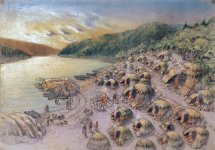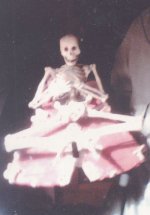Questions about people in the past and their haplogroups are always interesting. For me it is one of dilemmas
which haplogroup were belonged members of culture Lepenski Vir (Lepen Whirl). This culture originated about 9,000 years ago (7,000 BC), reaching the peak between 5,300 BC and 4,800 BC, in eastern Serbia on the banks of the Danube.

Lepenski Vir (Lepen Whirl) Wikipedia (quote):
http://en.wikipedia.org/wiki/Lepenski_Vir
"Archaeological findings in the surrounding area show evidence of temporary settlements, probably built for the purpose of hunting and gathering of food or raw materials. This suggests a complex semi-nomadic economy with managed exploitation of resources in the area not immediately surrounding the village, something remarkable for the traditional view of Mesolithic people of Europe. More complexity in an economy leads to professional specialization and thus to social differentiation.
This is clearly evident in the layout of the Lepenski Vir Ia-e settlement. The village is well planned. All houses are built according to one complex geometric pattern. These remains of houses constitute the distinct Lepenski Vir architecture, one of the important achievements of this culture. The main layout of the village is clearly visible. The dead were buried outside the village in an elaborate cemetery. The only exceptions were apparently a few notable elders who were buried behind the fireplaces in houses, according to a religious ritual.
The complex social structure was dominated by a religion which probably served as a binding force for the community and a means of coordination of activity for its members. Numerous sacral objects that were discovered in this layer support this theory. The most remarkable examples are piscine sculptures, unique to the Lepenski Vir culture, which represent one of the first examples of monumental sacral art on European soil."
I'd like to hear opinions about the possible haplogroup of these peoples. Some skeletons of these people have been saved and it may be possible to determine the haplogroup.

which haplogroup were belonged members of culture Lepenski Vir (Lepen Whirl). This culture originated about 9,000 years ago (7,000 BC), reaching the peak between 5,300 BC and 4,800 BC, in eastern Serbia on the banks of the Danube.

Lepenski Vir (Lepen Whirl) Wikipedia (quote):
http://en.wikipedia.org/wiki/Lepenski_Vir
"Archaeological findings in the surrounding area show evidence of temporary settlements, probably built for the purpose of hunting and gathering of food or raw materials. This suggests a complex semi-nomadic economy with managed exploitation of resources in the area not immediately surrounding the village, something remarkable for the traditional view of Mesolithic people of Europe. More complexity in an economy leads to professional specialization and thus to social differentiation.
This is clearly evident in the layout of the Lepenski Vir Ia-e settlement. The village is well planned. All houses are built according to one complex geometric pattern. These remains of houses constitute the distinct Lepenski Vir architecture, one of the important achievements of this culture. The main layout of the village is clearly visible. The dead were buried outside the village in an elaborate cemetery. The only exceptions were apparently a few notable elders who were buried behind the fireplaces in houses, according to a religious ritual.
The complex social structure was dominated by a religion which probably served as a binding force for the community and a means of coordination of activity for its members. Numerous sacral objects that were discovered in this layer support this theory. The most remarkable examples are piscine sculptures, unique to the Lepenski Vir culture, which represent one of the first examples of monumental sacral art on European soil."
I'd like to hear opinions about the possible haplogroup of these peoples. Some skeletons of these people have been saved and it may be possible to determine the haplogroup.


